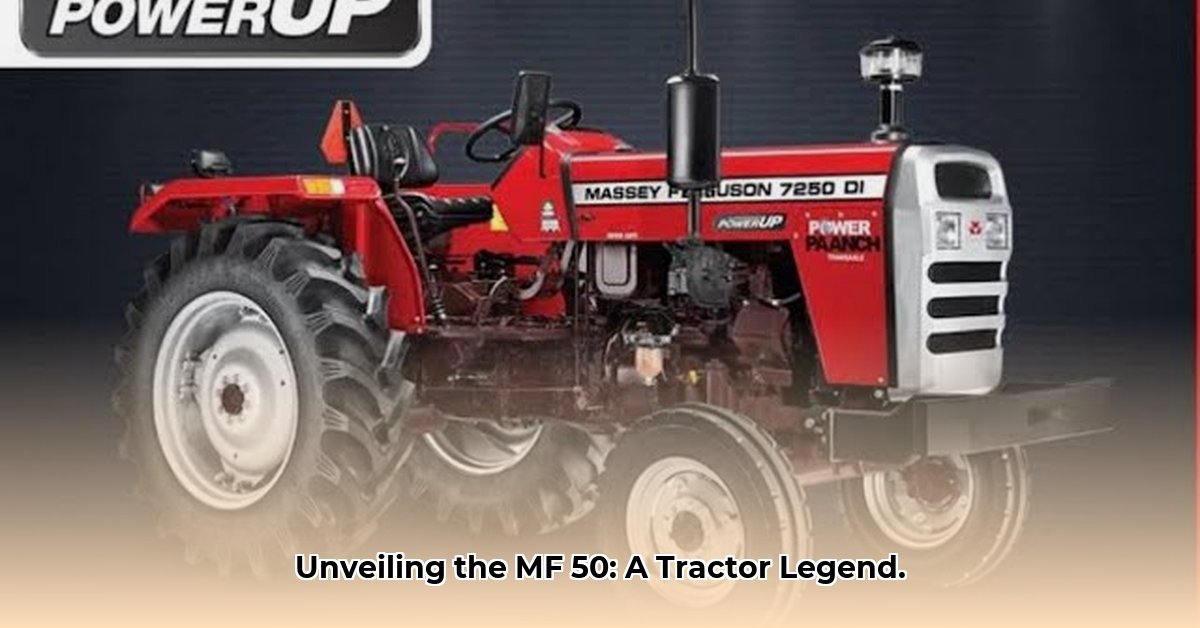
MF 50 HP Tractor: A Workhorse of the 1950s and 60s
The Massey Ferguson 50 (MF 50), a stalwart of the late 1950s and early 1960s, wasn't merely another farm tractor; it represented a pivotal shift in agricultural mechanization. For more detailed specifications, check out this MF 50 Specs. Its seven-year production run (1957-1964) signified a significant leap towards efficient farming practices, a period when farmers increasingly sought ways to boost productivity and ease workload. This tractor's appeal stemmed from its power, flexibility, and overall reliability.
Power Options: A Farmer's Choice
What fueled the MF 50's popularity? Farmers had options. For reliable power, the robust Perkins 2.5L three-cylinder diesel engine was a dependable choice. Those preferring gasoline could opt for the Continental 2.2L four-cylinder gasoline engine, or even an LP gas version—a significant advantage given fluctuating fuel availability and farm-specific needs. This adaptability was crucial, allowing farmers to match their tractors to their circumstances. But how did this translate into field performance? Tests revealed approximately 32.42 horsepower at the drawbar and roughly 38.33 horsepower at the power take-off (PTO) – a significant boost to productivity despite being slightly less than the advertised 42.2 horsepower. This discrepancy likely reflects variations in testing methodologies and conditions. Even with this difference, the power output represented a substantial increase in efficiency compared to earlier farming methods. Did this increased efficiency translate into savings for farmers? Further research into cost-per-acre worked would be valuable.
Production: A Popular Choice
The MF 50's production numbers speak volumes about its market success. While precise yearly figures are elusive, estimates suggest consistent, substantial demand:
| Year | Approximate Units Produced |
|---|---|
| 1957 | 510,764 |
| 1958 | 515,708 |
| 1959 | 522,693 |
| 1960 | 528,163 |
| 1961 | 528,419 |
| 1962 | 530,416 |
| 1963 | 533,851 |
| 1964 | 536,063 |
This sustained high production demonstrates the MF 50's widespread adoption. Its size proved ideal for various tasks while delivering sufficient power, effectively filling a market niche. The consistent demand suggests a significant impact on the agricultural landscape.
Sustainability: A Modern Perspective
While the MF 50 undeniably accelerated agricultural production, evaluating its environmental impact through a contemporary sustainability lens is crucial. Unfortunately, precise data on fuel efficiency (e.g., gallons per acre) and emissions remains scarce, hindering a comprehensive assessment. This data gap highlights the challenge of evaluating older technologies using modern sustainability metrics. Understanding the complete environmental impact requires comparing the MF 50 to its contemporaries—an area needing further investigation. It's vital to remember that technological progress isn't always linear, and older technologies, while historically important, may not meet today's stricter environmental standards. The MF 50 was a testament to its era's technological capabilities, and its assessment must consider its historical context.
A Lasting Legacy
The MF 50, though seemingly antiquated compared to modern machinery, marks a significant step in agricultural technology. Its design, engine choices, and widespread adoption laid the groundwork for future innovations. The tractor stands as a testament to agriculture's continuous pursuit of efficiency and productivity. Its contribution extends beyond purely economic gains; its influence shapes agricultural practices even today. Its legacy encompasses not just increased yields, but also its position within the broader story of agricultural technological advancement. Analyzing its history provides invaluable insights into farming's evolution and the challenges of sustainable food production in the present and future. The MF 50's influence continues to resonate, shaping how we farm today and reminding us of the continual evolution of agricultural technology.
How to Assess the Environmental Impact of Early Agricultural Machinery like the Massey Ferguson 50
Key Takeaways:
- The MF 50's relatively modest horsepower, compared to modern tractors, likely resulted in lower fuel consumption and reduced emissions per acre worked.
- The impact on soil compaction requires further investigation, considering the tractor's weight and the tire technology of that era.
- A complete environmental impact assessment necessitates considering production methods, material sourcing and the tractor's end-of-life management.
Understanding the MF 50's Footprint
Assessing the MF 50's environmental impact demands a holistic approach, encompassing its entire lifecycle. This evaluation needs to extend beyond fuel consumption.
Fuel Efficiency: The MF 50's comparatively low horsepower engine likely burned less fuel per hour than modern tractors. However, was this lower consumption due to inherent efficiency, or simply a consequence of its limited power output? This distinction is central to assessing its contribution to greenhouse gas emissions. Concrete data on fuel usage under varying conditions is fundamentally important.
Soil Compaction: The tractor's weight and tire design significantly influenced soil health. How did the MF 50's design impact soil compaction? Did contemporary farming methods exacerbate or mitigate these effects? Addressing this requires consultation with historical agricultural research and relevant farming practices of the era.
Manufacturing and Materials: What materials comprised the MF 50? What were the environmental implications of their production? What were the emissions from the manufacturing process itself? Detailed information on the manufacturing process is crucial for a comprehensive assessment.
Maintenance and Repair: How straightforward was the MF 50's maintenance and repair? Frequent repairs might offset the benefits of lower fuel consumption. High repair frequency implies greater resource consumption (parts, labor), thus, increasing its overall environmental impact. A longer lifespan naturally contributes to better overall environmental performance.
End-of-Life: What happened to MF 50 tractors after their useful life? Were they properly recycled or discarded in landfills? This factor is critical in the overall lifecycle assessment.
MF 50 Specifications (Illustrative Example)
| Specification | Value | Notes |
|---|---|---|
| Engine | Perkins 4-cylinder diesel (or other options) | Varied based on model and year |
| Horsepower | 50 hp (nominal) | Actual power varied during operation |
| Transmission | Gearbox | Typical for era |
| Weight | ~5,000 lbs (approx) | Approximate; varied by configuration |
This data is exemplary and may vary based on the specific model and year. Access to detailed production records would greatly enhance the accuracy of the analysis.